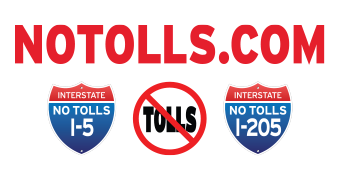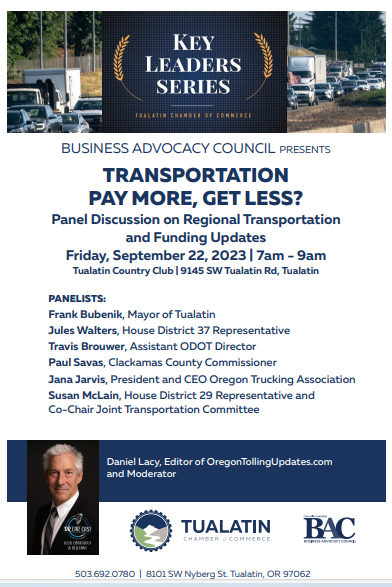Truckers supported HB 2017 because it added freeway lanes, now eliminated
Monday, September 25, 2023
By John Ley for Clark County Today
There was a lot of “truth telling” by the elected representatives of small cities along I-205 at the Tualatin Chamber of Commerce breakfast meeting Friday morning. The chamber hosted a gathering of key leaders to discuss “Transportation, pay more, get less?” City Council meetings have been inundated with citizens expressing concerns and outrage regarding the Oregon Department of Transportation’s (ODOT) plan to toll the freeway. It will cause a great deal of traffic diversion and make vehicle travel unaffordable for some residents who rely on the freeway multiple times a day.
Traffic is projected to increase by 100 percent on Willamette Falls road, which is one of many arterials already over congested, according to West Linn Mayor Rory Bialostosky. Tualatin Mayor Frank Bubenik wanted to know “which roads will be fixed” as ODOT officials say they are committed to trying to mitigate the impacts of traffic diversion. Yet last week, Clackamas County Commissioner Paul Savas told the Regional Toll Advisory Committee (RTAC) that the $30 million ODOT has allocated for mitigation is “woefully inadequate.”
Jana Jarvis of the Oregon Trucking Association (OTA) reminded people that Portland has three of the worst bottlenecks for traffic congestion in the nation. They are the Rose Quarter, the Interstate Bridge, and I-205. “It’s the only urban two-lane section of freeway between Canada and Mexico,” she said, speaking of I-5 at the Rose Quarter.
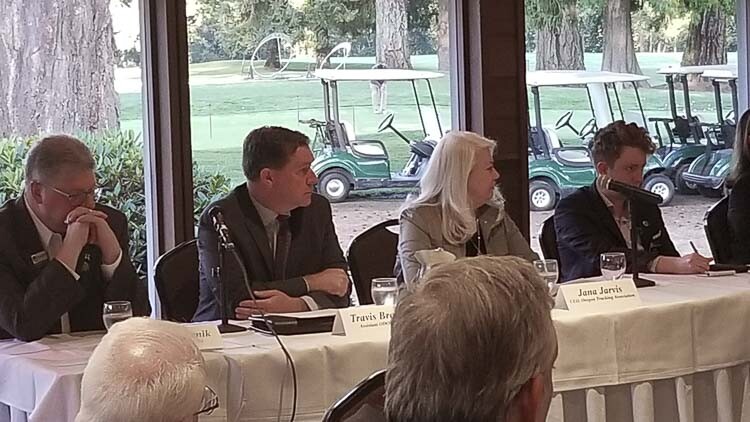
Slowing down freight haulers raises the cost of goods and products. The OTA supported HB 2017 because it added a through lane to I-5 at the Rose Quarter, as well as addressed needs on I-205 and other transportation corridors. Now, none of the promised additional lanes are being added.
“There has been a historic under investment in roads,” she said. It has been over 40 years since new vehicle capacity was added to the Portland metro area with the creation of I-205. Regional population has doubled since then.
Clark County Councilor Michelle Belkot is a member of RTAC and she attended Friday’s meeting. She knows there is a disconnect in messaging, between what is often heard from Vancouver Mayor Anne McEnerny-Ogle, who sits on multiple regional transportation committees, and the position of the Clark County Council. The council has taken a position against tolling, knowing that people north of the Columbia River have voted three times against tolling as a funding mechanism for transportation projects.
Belkot heard the many small town representatives voice strong concerns about traffic diversion due to tolling, and the unaffordable nature of tolls on so many families in the region. Clark County has roughly 75,000 people who earn a paycheck in Oregon. They would be negatively impacted once Oregon imposes tolling on all area freeways.
Emcee Daniel Lacy mentioned the fact that the regional plan will toll all lanes, about 42 miles of both I-5 and I-205 south of the Columbia River. He asked the panel “how will the revenue generated by tolling decrease congestion on I-5 and I-205 without increasing diversion?”
ODOT’s Travis Brouwer told the group Portland has the 15th worst traffic congestion in the nation, and the 37th worst in the world. Congestion costs the average person $1,200 per year, according to Brouwer. “Tolling really is going to be a way for us to help build the projects,” he said, referring to the multiple transportation projects in the region now on hold.
Oregon Rep. Susan McLain, an ardent proponent of transit, said “we have to get as many people as possible back on the freeway.” Someone in the audience quietly said “she doesn’t believe that” to the person next to them. McLain has strongly supported replacing the 3-lane Interstate Bridge with another 3-lane bridge for the Interstate Bridge Replacement (IBR) project.
Oregon’s freight haulers supported HB 2017 because they were promised a third through lane on I-5 at the Rose Quarter, in addition to other vehicle capacity additions. Jarvis mentioned several groups have successfully killed a third lane at the Rose Quarter, put a 3rd lane on hold for I-205, and limited the IBR to just three through lanes.
Many on the panel told tales of huge traffic congestion already on the side roads, due to the lack of freeway vehicle capacity. Bubenik said city councils are catching all the heat from angry citizens. “Diversion will get worse,” under the current plan he noted.
A group of school administrators from Clackamas County attended. Their concern was the expected increase in traffic diversion was going to negatively impact traffic in front of or near several area schools. They told Belkot average school bus travel times would increase by 15 minutes, in addition to adding significant safety concerns.
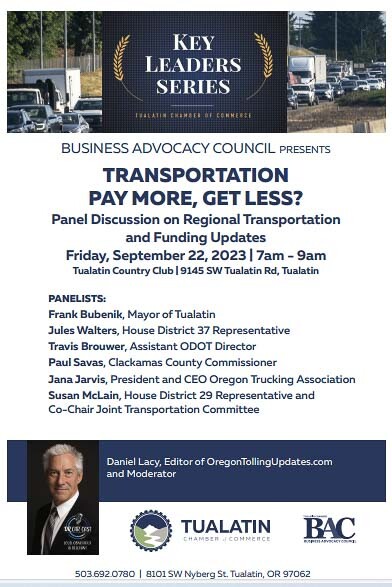
The Tualatin Chamber of Commerce Key Leaders event asked the question: “Transportation, pay more, get less?” Six leaders from small communities along I-205, the Oregon legislature, the Oregon Trucking Association, and ODOT answered questions relevant to the planned tolling of both I-205 and I-5. Graphic courtesy of Tualatin Chamber of Commerce.
Bialostosky noted ODOT officials previously telling people that the completed I-205 project would eliminate 12 hours of congestion. Now the seven miles of new lanes between the Abernethy Bridge to Stafford Rd. has been put on hold, he wondered if there was going to be any reduction in the forecast 14 hours of traffic congestion ODOT had predicted for 2045.
Rep. Jules Walters said this is a problem that should have been fixed a decade ago. Bialostosky noted adding a third lane was key to creating a “managed lane.” It could be tolled while allowing other vehicles to use the general purpose lane to avoid tolls. That offered the best “equity” he said.
David Ungemah from WSP told the RTAC committee last week that when managed lanes are created, “there is more traffic coming off the arterials, back onto the freeway.” He told Jarvis there was “an improvement when a new tolled lane was added” with the increased capacity.
“We look at the cost of those projects that could be paid for tolls,” Brouwer said, “we’d be looking at about 20 to 25 cents statewide gas tax increase, just to pay for those.” He saw tolling as the only way to pay for the projects. “There’s no way we’re gonna get all those projects without another revenue source,” he said.
His agency told the Oregon legislature the projects in HB 2017 could be built for $5.3 billion. Today, ODOT officials are telling people they have a $3 billion funding shortfall. This is in spite of Oregon and all states receiving significant money from the federal government, via the $1.2 trillion Infrastructure Investment and Jobs Act (IIJA). Oregon and Washington were expecting at least $14 billion in federal funds from the IIJA..
“Tolls are a much more expensive way to pay for transportation projects than fuel taxes,” Jarvis said. She noted the cost to collect the gas tax is about ½ percent, whereas tolling’s cost of collection can be 40 percent. Seattle’s I-405 tolling system had a 43 percent cost of collection prior to the pandemic. It rose to 68 percent two years ago.
That 20 to 25 cent gas tax increase would be less than half the 50 cent per gallon increase in Washington gas prices, due to the Gov. Jay Inslee carbon tax. Gas prices began rising in January and are now the highest or second highest in the nation behind California.
Oregon is one of a handful of states that don’t spend General Fund money on transportation, Jarvis mentioned. Washington state has had to allocate General Fund revenues to cover shortfalls in the state’s five tolling facilities revenues for the past three years. Tolling revenues can be very volatile. Walters emphasized that “40-50 percent of tolling dollars goes out the door to pay for the cost of collection.

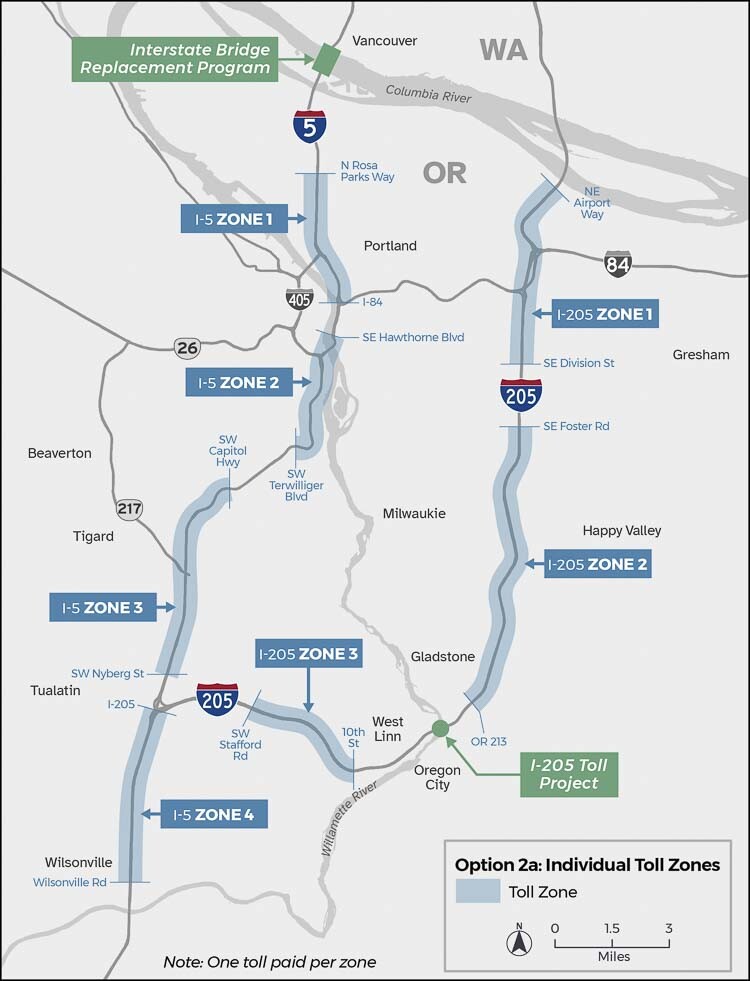
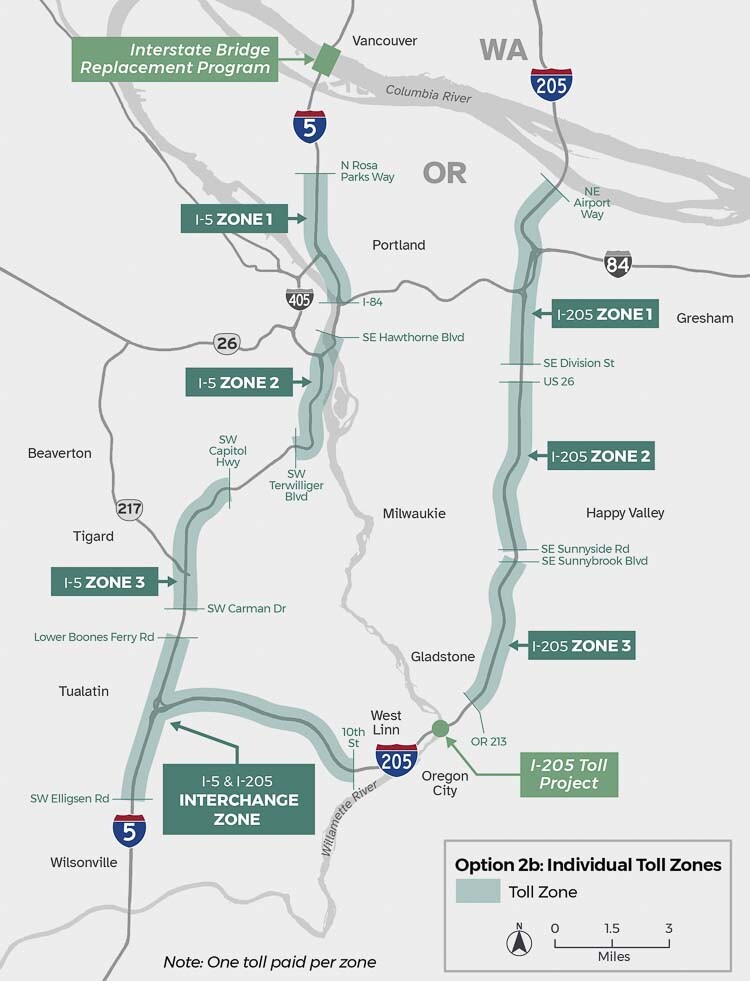
ODOT has proposed three possible options for tolling under its Regional Mobility Pricing Program. None are set in stone, as Oregon Gov. Tina Kotek has “paused” tolling until Jan. 2026. ODOT is looking for a new revenue source to fill a $3 billion funding hole in transportation projects. Graphics courtesy ODOT
Seated in the audience were Dean Suhr and Julie Parish. They are leading the effort to deliver a Vote Before Tolls can be placed on any Oregon road. Supporters are collecting signatures on IP-4 to put that initiative on the November 2024 ballot.
Washington County Commissioner Roy Rogers was there. He participated in the ODOT “Value Pricing” Policy Advisory Committee in 2017 and 2018, along with Jarvis and Savas. They witnessed the most common sense alternative being discarded by ODOT and WSP staff.
Also in the audience were staff members of Congresswoman Lori Chavez-DeRemer (OR-05). She has introduced legislation to prohibit tolling on I-5 and I-205 in Oregon. The No Tolls on Oregon Roads Act would rescind federal tolling authority granted to states specifically on Interstate 5 and Interstate 205 in Oregon.
“Oregonians are understandably fed up with the state’s attempt to hastily implement tolling, and I want to give drivers peace of mind by making the current ‘pause’ permanent,” Chavez-DeRemer said. “By blocking tolling along I-5 and I-205, my No Tolls on Oregon Roads Act would protect our communities from traffic congestion, save families from paying a regressive tax, and support businesses by keeping transportation costs lower. As a member of the Transportation and Infrastructure Committee’s Highways and Transit Subcommittee, I’ll continue working closely with my colleagues to put a stop to this unfair interstate tax.”
Jarvis noted that the huge amount of traffic congestion is bad for the environment. “The cost of congestion equals 400,000 (truck) drivers idling,” she said.
“This particular tolling system (as proposed) is deeply flawed,” said Walters. “It’s unequitably putting this toll on the backs of people that live in Tualatin, and Lake Oswego, Oregon City and Gladstone.” Not only would they be footing an unfair portion of the bill, but those communities would be stuck with the consequences of traffic diversion. “This is the worst possible scenario,” she concluded.
For more information, visit OregonTollingUpdates.com.
